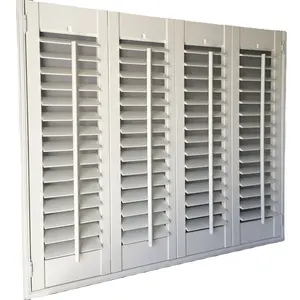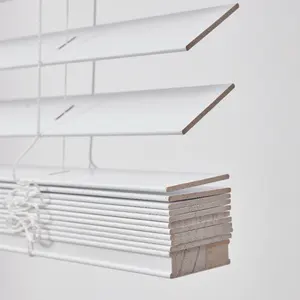Introduction
Welcome to the world of window wooden blinds, where functionality meets style. Wooden blinds are more than just window coverings; they are a statement of taste and a reflection of your personal style. With their timeless appeal, they can transform any space, adding warmth and elegance. Whether you prefer the rustic charm of real wood or the practicality of faux wood, there's a style to suit every decor. In this article, we delve into the aesthetic appeal of wooden blinds, their functionality, and how to choose the right ones for your windows. We also provide tips on installation, whether you prefer a DIY approach or professional help.
The Aesthetic Appeal of Wooden Blinds
Wooden blinds add a touch of class to any space. Their natural look gives off a warm vibe, creating an inviting atmosphere in the living room. They complement both traditional and modern interiors due to their timeless appeal. Their versatility is also noteworthy as they come in various stains, finishes, and slat sizes, which lets you customize them according to your decor needs. So whether you want something rustic or sleek – there’s always a pair of wooden blinds for every style.
Different Styles of Wooden Blinds
Wooden blinds come in two main styles: real wood and faux wood. Real wood blinds are crafted from genuine hardwoods such as basswood, oak, or cherry. They offer a natural fine grain and unique character. Faux wood blinds are constructed from polystyrene and designed to withstand humid conditions. They mimic the luxurious look of real wood with realistic grain patterns and finishes. Both styles can be customized with a wide selection of finishes, slat sizes, and decorative elements.
How to Match Wooden Blinds with Your Interior Design
Wooden blinds are versatile, matching well with various textures, colors, and materials. The color scheme of your decor should consider the tone and overall look of your blinds. For a cohesive look, find low-contrast items that match the tones of the wood. If you prefer a higher contrast look, consider the tone of your wood to find pieces that complement it while standing out. Lighter-colored woods like oak are often used in more modern spaces, while darker woods provide a more traditional design. Textures are also important to consider when decorating your space, providing contrast to the hard and smooth wooden blinds.
The Functionality of Wooden Blinds
Wooden blinds are a functional choice for window coverings. They are durable and long-lasting, made from sturdy material that can withstand the elements. Custom-made to fit any window size, they provide optimal insulation, keeping conditioned air inside. The thicker and heavier slats offer more privacy and light control, creating a blackout effect when needed. They are also energy-efficient, helping to reduce energy usage and costs. Plus, they require very little maintenance, needing only a simple wipe down to remove dust.
Light Control and Privacy
Wooden blinds offer excellent light control and privacy. Their larger slats provide a great exterior view and let in ample light, but they may offer limited privacy. Conversely, smaller slats offer more privacy but less light control. The lift and tilt feature of blinds allows for precise control over the amount of light entering a room. However, due to the many moving parts, blinds may not completely block light. They are ideal for rooms where variable light levels are desired, but minimal light leakage is not a problem.
Insulation and Energy Efficiency
Wood blinds do offer some insulation, contributing to energy efficiency in your rooms. However, they are primarily recommended for blocking out summer sunlight to reduce heat entering your rooms. The insulation value of materials is measured using R-values, with higher values indicating better insulating power. Real wood blinds are better at keeping warmth out of your house, rather than retaining it inside. This is due to the design style, with gaps between the slats and along the sides, providing paths for heat loss.
Durability and Ease of Maintenance
Faux wood blinds are made of synthetic wood, while real wood blinds are made of natural wood. Both types are known for their style and durability, adding warmth and character to a room. However, each has its own advantages and disadvantages. If you're looking for a practical and budget-friendly option, faux wood blinds may be the best choice. On the other hand, if you're seeking a luxurious and beautiful window covering, real wood blinds are the obvious choice. Both real wood and faux wood blinds offer durability, but the choice ultimately comes down to personal preference.
Choosing the Right Wooden Blinds for Your Windows
When choosing the right wooden blinds for your windows, it's crucial to consider the room's needs and the shape of your windows. The activities taking place in each room will determine the degree of light control you need. For instance, bedrooms require blinds that can effectively shut out light. Also, the shape and size of your windows matter. If you have large or unusually shaped windows, you'll need blinds that fit well and are easy to operate. Remember, blinds that don't fit your windows won't function properly and will detract from the aesthetic appeal of your room.
Considerations for Size and Slats
Choosing the right slat size for your wooden blinds is crucial for achieving the desired light control and privacy. Smaller slats offer more light seepage points, while larger slats, when fully open, allow more sunlight to enter. Your window's orientation also influences the slat size choice. For instance, north or east-facing windows may benefit from smaller slats. Consider the room's purpose as well; more private areas may require smaller slats for increased privacy. Remember, larger slats usually come with a higher price tag, so budget considerations are also important.
Selecting the Right Color and Finish
Selecting the right color and finish for your wooden blinds is crucial to complement your interior design. Our custom wood blinds are available in rich natural finishes and neutral colors such as Golden Oak, Mahogany, Walnut, Espresso, Ash Wood, White, Pewter, and White Dove. These blinds can be further customized with decorative fabric tapes, motorized tilt, and a variety of cord and wand options. Our eco-friendly products are made from 100% basswood that is kiln-dried for durability and coated to resist scratches and UV damage.
Installation Tips for Wooden Blinds
Installing wooden blinds can be a DIY task if you follow the right steps. Start by preparing and marking the bracket locations. Install the brackets into the wall or window frame. Attach the valance clips to the headrail and then install the blind into the brackets. If your blinds have a wand control, attach it next. Finally, attach the valance to the valance clips. Remember, the brackets must be securely attached to the mounting surface and the blind's weight should be considered when selecting a fastener.
DIY Installation Guide
Wood blinds are versatile window coverings that can add warmth to a room and provide privacy. They can be installed in three ways: inside mount, outside mount, and ceiling mount. The style you need can depend on the look you want or the type of window that you have. Alternatively, you can have a professional install the blinds for you. Wood blinds can be selected to match the other wood finishes in your home.
Professional Installation: Pros and Cons
The decision to install wooden blinds yourself or hire a professional can be a challenging one. Each option has its pros and cons, and the best choice will depend on factors such as your budget, skills, and the complexity of the installation. Professional installation can save time and ensure a high-quality result. However, it might be more costly than a DIY approach. Consider your individual needs, preferences, and circumstances before making a choice.
Conclusion
In conclusion, wooden blinds are a perfect blend of style and functionality. They offer a timeless aesthetic appeal, complementing both traditional and modern interiors. With their versatility in styles, finishes, and slat sizes, they can be customized to suit your decor needs. Functionally, they provide optimal insulation, light control, and privacy, while being durable and easy to maintain. Choosing the right blinds involves considering the room's needs, window shape, slat size, and the desired color and finish. Whether you opt for a DIY installation or hire a professional, wooden blinds are a worthy investment for your home, enhancing its aesthetic appeal while providing practical benefits.






























 浙公网安备 33010002000092号
浙公网安备 33010002000092号 浙B2-20120091-4
浙B2-20120091-4